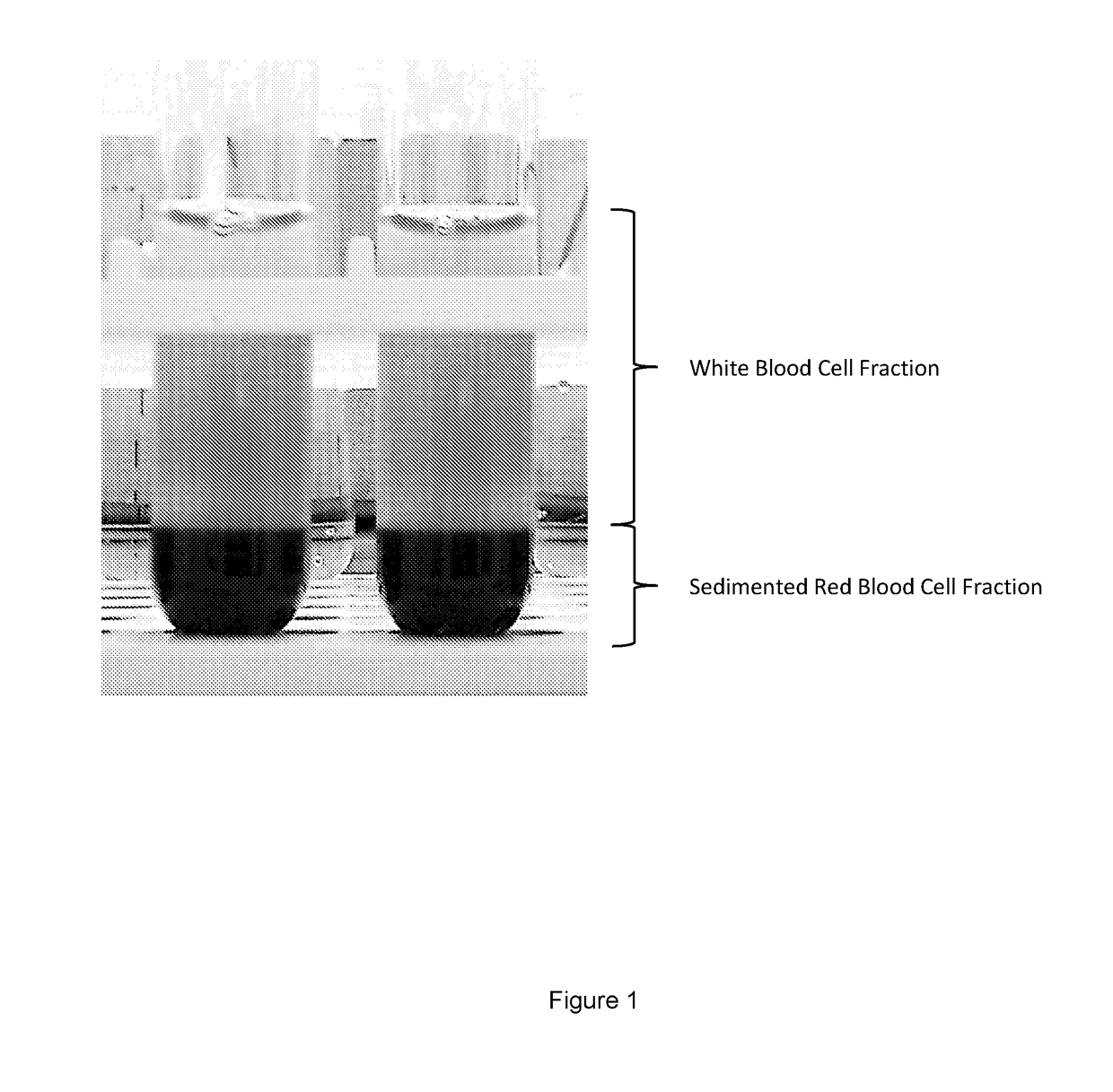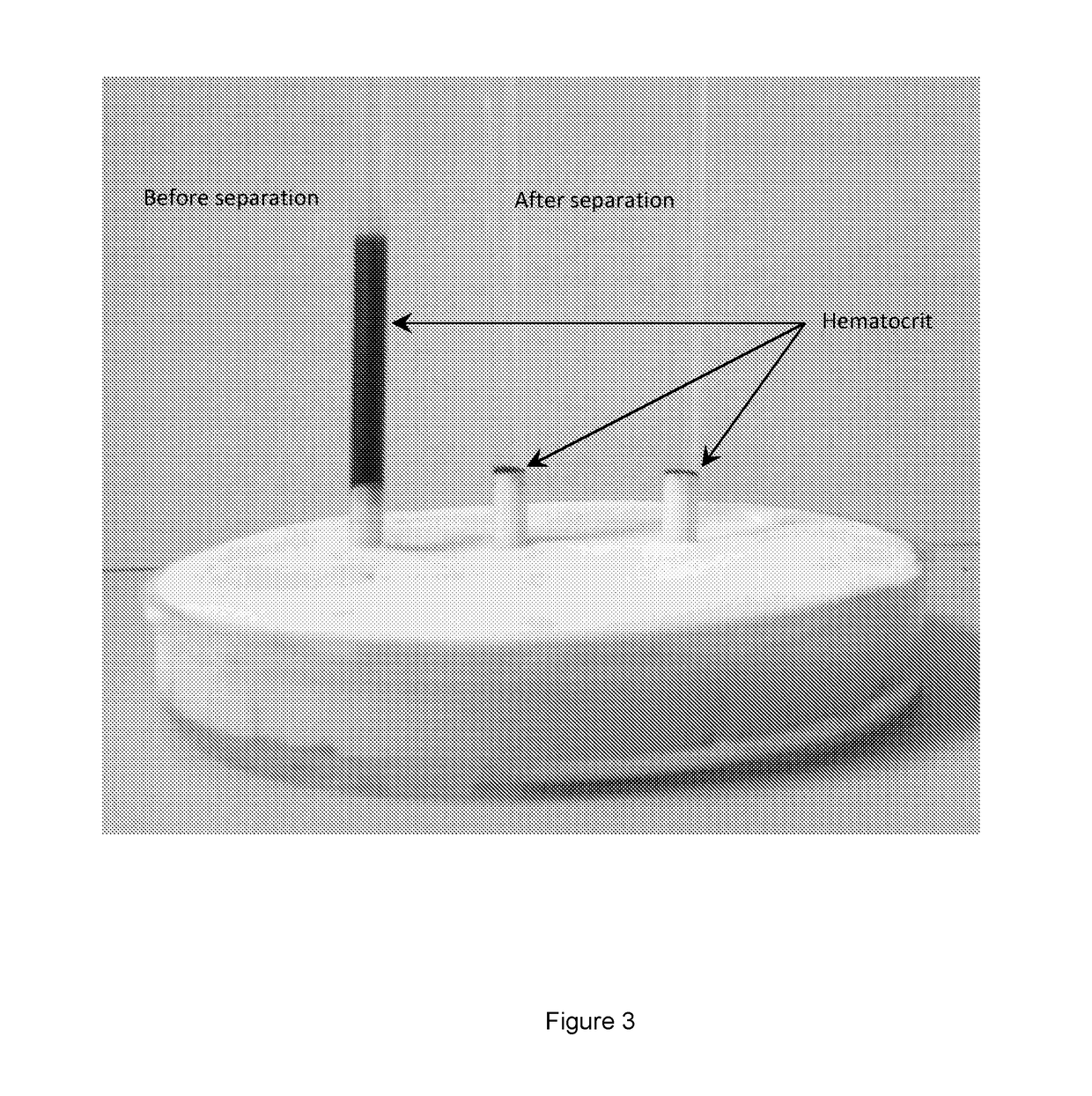Methods of cell separation
a cell and cell technology, applied in the field of cell separation, can solve the problems of reducing the yield of desired cell subsets, reducing the recovery of desired cells, and reducing the yield of desired cells,
- Summary
- Abstract
- Description
- Claims
- Application Information
AI Technical Summary
Benefits of technology
Problems solved by technology
Method used
Image
Examples
example 1
General Cell Separation Method
[0183]Umbilical cord blood was collected into standard Baxter 250 ml (nominal) blood bags containing 35 ml of a citrate phosphate dextrose adenine (CPDA) anticoagulant solution.
[0184]A solution containing dextran and a further constituent selected from dimethyl sulphoxide (DMSO), dimethyl glycine (DMG), L-valine, L-proline, β-alanine, leucine, isoleucine and glycine, in phosphate-buffered saline (PBS), was prepared. This solution was added to a blood sample at a ratio of 1:1, this was then mixed thoroughly. Separation of the erythrocyte and nucleated cell fractions took place at room temperature within a time period of 15 or 30 minutes.
[0185]Separation of the cell fractions could be observed visually. FIG. 1 shows clear separation of the erythrocytes (bottom of test tube) from the nucleated cells (top of test tube). This image was taken 30 minutes after exposure to dextran (500 molecular weight (Mw)) at a final concentration of 2.5% w / v and DMSO at a fi...
example 2
Erythrocyte Volume Fraction (Haematocrit) Study
[0190]In this Example, the levels of erythrocyte volume fraction remaining in the nucleated cell fraction after cell separation were determined. Three tubes were prepared for the separation: (i) blood sample mixed at a ratio of 1:1 with PBS only (control), (ii) blood sample mixed at a ratio of 1:1 with a solution containing 500 Mw dextran at a concentration of 5% w / v in PBS (final concentration of dextran of 2.5% w / v), (iii) blood sample mixed at a ratio of 1:1 with a solution containing 500 Mw dextran at a concentration of 5% w / v and DMSO at a concentration of 5% v / v in PBS (final concentration of dextran of 2.5% w / v and of DMSO of 2.5% v / v). Samples were left to separate for 30 minutes at room temperature.
[0191]It was observed that the cell fractions in sample (iii) separated at a faster rate than in sample (ii) and, after 30 minutes, sample (iii) had developed a more compact erythrocyte fraction compared to sample (ii) (data not show...
example 3
Assessment of Cell Viability and the Presence of Hematopoietic Stem Cells (HSCs) using Flow Cytometry
[0194]A blood sample was mixed at a ratio of 1:1 with a solution containing 500 Mw dextran at a concentration of 5% w / v and DMSO at a concentration of 5% v / v in PBS (final concentration of dextran of 2.5% w / v and of DMSO of 2.5% v / v). Samples were left to separate for 30 minutes at room temperature.
[0195]A sample of the resulting nucleated cell fraction was then analysed using flow cytometry. In particular, analysis was carried out using a “Stem Cell Enumeration Kit” obtained from Becton, Dickinson and Company. Analysis was carried out as per the Application Guide provided with the Kit and the templates used are based on a method featured in the Clinical and Laboratory Standards Institute H42-A2 approved guideline (Enumeration of Immunologically Defined Cell Populations by Flow Cytometry; Approved Guideline-Second Edition. Wayne, PA: Clinical and Laboratory Standards Institute; 2007....
PUM
| Property | Measurement | Unit |
|---|---|---|
| molecular weight | aaaaa | aaaaa |
| temperature | aaaaa | aaaaa |
| temperature | aaaaa | aaaaa |
Abstract
Description
Claims
Application Information
 Login to View More
Login to View More - R&D
- Intellectual Property
- Life Sciences
- Materials
- Tech Scout
- Unparalleled Data Quality
- Higher Quality Content
- 60% Fewer Hallucinations
Browse by: Latest US Patents, China's latest patents, Technical Efficacy Thesaurus, Application Domain, Technology Topic, Popular Technical Reports.
© 2025 PatSnap. All rights reserved.Legal|Privacy policy|Modern Slavery Act Transparency Statement|Sitemap|About US| Contact US: help@patsnap.com



